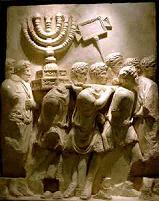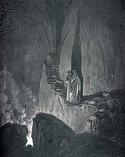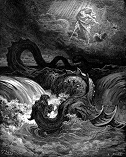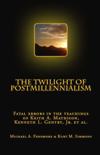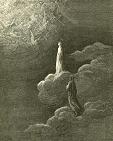An Open Letter to Mac Deaver
Kurt Simmons
Dear Mac,
I appreciated your debate with Don Preston and admired your command of God’s word. I respect your learning and labor in the Lord greatly. Bill Fangio showed me your letter to him dated 5/6/08. I thought it might be profitable if we could correspond a bit on the topic of eschatology. Your letter mentioned two topics, so I will try to confine myself to them: 1) the new heavens and earth; 2) the resurrection of I Cor. 15.
In preface, let me say that the church of Christ of the Stone/Campbell Movement has never been strong in eschatology. In fact, there is a tendency to avoid it. Few congregations would feel comfortable or capable of undertaking a study of Revelation or even comparably simple passages like Matthew 24. Ask the average minister who the “man of sin” refers to and you will not receive a definitive answer. We seem to be comfortable not knowing, as if these parts of God’s word are better left alone.
There is also a tendency to avoid Old Testament studies, or at least to down-play these as “unnecessary.” Most of our members are unfamiliar with the language of the prophets, if they study them at all, and are ill-equipped to make a studied judgment about the literalness of the language they employ. When they encounter language in the New Testament about the “day of the Lord” or of a “collapsing universe” they are totally unequipped to approach it in an intelligent way. Identical language to that used by Peter in his second epistle occurs all through the Old Testament to describe times of divine judgment upon the nations. Yet our people, completely ignorant of those examples, must grope in the darkness, assuming that the language is purely literal. Any suggestion that this language is figurative is thought incredulous, not because examples cannot be brought forward to demonstrate that proof, but because our people have never heard it before. We are not the “Bible toting, Bible quoting” people we once used to be.
Our people’s lack of grounding in the Old Testament is the more disconcerting when we consider that the New Testament is the Old Testament fulfilled. How strange that the Old Testament nowhere predicts the destruction of the earth at Christ’s second coming. Just the opposite, the Messiah was to bring in a kingdom and reign of ever-lasting righteousness, a time of renewal and unprecedented peace, when men and nations were reconciled to each other and to God. But we teach that Jesus’ ultimate objective is to destroy the whole earth! (I am reminded of James and John who asked if they should call down fire on the Samaritans, and the Lord’s answer, the Son of Man came to save, not destroy.) Where is it ever taught by the prophets that the Messiah would destroy the earth?!! The standard eschatology of our churches introduces a total disparity between the testaments when they affirm that Christ will come to destroy the earth and cosmos. Far from the New Testament being the fulfillment of the Old, it is as if there were a total break in the eschatology of the Old Testament and the New! My challenge: Identify a single Old Testament passage that unambiguously affirms the cosmos would be destroyed by Christ.
Just a short time ago it would have been deemed heretical to teach that Revelation spoke to events fulfilled in the first century. The moving figures of the Restoration Movement were not of this mind (Campbell’s Millennial Harbinger thought the Millennium was near at hand, not on the basis of what the Bible taught, but upon his idea of world population and the necessity for Christ’s return to save us from overpopulation!). Yet, in the 1900’s we begin to witness a very definite movement toward the view that Revelation was mostly, if not totally, fulfilled by A.D. 70. Names like Ulrich Beeson and Foy E. Wallace, among countless others, began teaching a contemporary-historical fulfillment of Revelation in the mid 1900’s. One brother – Clifton Voss (Chickasha, OK) – had his tombstone engraved about 1955 with a time-line affirming Christ’s coming in A.D. 70, and that we are today living in the new heavens and earth (if you would like, I will email you pictures of the Voss headstone, it is a great human interest piece). Needless to say, these men (much like Campbell, and others before them) met with scorn and derision in their time from the “faithful brethren” but, lo and behold, today Sunset School of Preaching, Lubbock, TX, teaches Revelation from a fulfilled perspective! Marvels never cease. Yesterday’s heresies are admitted facts today. My point in this is to show that our churches are in a state of flux on questions of eschatology. There has been a tendency to avoid these questions in the past, but as we study them we are definitely moving - as a brotherhood - in the direction of a contemporary-historical analysis, if not full Preterist, certainly at least partial Preterist in approach. And this movement is by no means confined to the churches of Christ. From rejecting the “late date” of Revelation, to the significance assigned to the number of the beast as Nero’s name, the trend toward interpreting eschatology in light of a contemporary-historical analysis (Preterist) is breaking out all over.
You agree in your letter that the new heavens and earth seem in some form or manner to speak to present era and church (citing Isa. 65:17). I am encouraged that you agree Isaiah’s prophecy is fulfilled. Certainly, this is the way Stephen must have understood it when he cited the prophecy before the Sanhedrin, when accused of saying Christ would come and destroy the temple and change the customs Moses delivered to the people (Acts 6:14; 8:48, 49). Effectively, Stephen’s defense was that he was not saying anything Isaiah had not prophesied long before. Stephen’s only addition was to announce that it was coming to fulfillment in their day. Isa. 66:15 specifically mentions the Lord coming in “fire” with whirlwinds and chariots to avenge the persecution of his saints and the Jews’ obstinate refusal to abandon the temple service and acknowledge the sacrifice and priesthood of Christ (Isa. 65:3-6). Obviously, such language becomes enormously important when we encounter New Testament prophecies like those contained in Matthew 24, Acts 2:14-40 (cf. Joel 2:28-32), Heb. 10-12, II Pet. 3 and Revelation. Hebrews 12:26 specifically mentions shaking the heavens and earth; II Pet. 3 and Revelation both close with the theme of a new heavens and earth that would obtain following a time of world wrath in which the powers that be were shaken, and the thrones of kingdoms overthrown (cf. Haggai 2:6). Given the historical context of Isaiah’s prophecy as defined by Stephen, and Joel’s prophecy as defined by Peter (both in Acts), any fair analysis must own that the events of the first century claim the most probable period of fulfillment. Peter said “Save yourself from this untoward generation” (Acts 2:39). This day of the Lord (v. 20) would overtake Peter’s generation. Must we not conclude it is the same day of the Lord of his second epistle? What justification could there be to look past the first century to our time and beyond? Certainly, many prominent church men down through the centuries have understood these prophecies are already fulfilled. One very early source that may be cited in proof of fulfillment is Origen:
“We do not deny, then, that the purificatory fire and the destruction of the world took place in order that evil might be swept away, and all things be renewed; for we assert that we have learned these things from the sacred books of the prophets…And anyone who likes may convict this statement of falsehood, if it be not the case that the whole Jewish nation was overthrown within one single generation after Jesus had undergone these sufferings at their hands. For forty and two years, I think after the date of the crucifixion of Jesus, did the destruction of Jerusalem take place.”[1]
Another is our own Foy E. Wallace Jr, who said:
“The heaven and earth, and troubled sea, having passed away and represented as being no more, indicated the changed conditions within the existing governments and society to make them favorable for the prosperity of the cause of Christ and his church throughout the empire…the vision represented the new conditions to surround the church in the changed world.”[2]
Both of these writers thus affirm the new heavens and earth are a present reality. To these may be added famous names like Bishop John Lightfoot, John Owen, Charles Spurgeon, Jonathan Edwards, and others. All this to say, the burden of proof must be very heavy indeed for those that would argue, as you do, that there is some further fulfillment of these prophecies remaining. Peter mentions a promise. What and where is that promise, if not Isaiah? If Isaiah is applied by Stephen to his day, by what process or justification do we apply it to our future? Is it the “sound” or “feel” of the language Peter employs? What of it? This kind of language has a long history in the prophets, who consistently use it figuratively. Sir Isaac Newton said this about the usus loqendi of the prophets regarding the “heavens and earth”:
"The figurative language of the prophets is taken from the analogy between the world natural and an empire or kingdom considered as a world politic. Accordingly, the world natural, consisting of heaven and earth, signifies the whole world politic, consisting of thrones and people, or so much of it as is considered in prophecy; and the things in that world signify the analogous things in this. For the heavens and the things therein signify thrones and dignities, and those who enjoy them: and the earth, with the things thereon, the inferior people; and the lowest parts of the earth, called Hades or Hell, the lowest or most miserable part of them. Great earthquakes, and the shaking of heaven and earth, are put for the shaking of kingdoms, so as to distract and overthrow them; the creating of a new heaven and earth, and the passing of an old one; or the beginning and end of a world, for the rise and ruin of a body politic signified thereby. The sun, for the whole species and race of kings, in the kingdoms of the world politic; the moon, for the body of common people considered as the king's wife; the stars, for subordinate princes and great men; or for bishops and rulers of the people of God, when the sun is Christ. Setting of the sun, moon, and stars; darkening the sun, turning the moon into blood, and falling of the stars, for the ceasing of a kingdom.”[3]
Before we cast aside long, established usage and treat Peter’s language literally, we ought to require a solid exegetical basis. I put forth my challenge again: name one Old Testament prophet who taught the Messiah would come and destroy the cosmos. And if this is not what the prophets taught, why do we put these words into Jesus’ and the apostles’ mouths?
Regarding the resurrection, there does appear to have been some misunderstanding in the debate, as you suggest. Most people probably felt you believed in the resurrection of physical bodies or seemed to change positions midway in the debate. I am glad to see (and will pass along to others) that what you actually believe is a resurrection from physical death. In this you and I are wholly agreed. However, I fail to see how you can postpone man’s deliverance from the power of sin and death to the future. The deliverance of man from Hades was, perhaps, the most urgently looked-for promise of the Messiah. Isaiah and Hosea spoke specifically to this work; it is also implicit in many of the Psalms; the “sure mercies” of David looked to the ransom of the soul from death. Certainly, resurrection was the great object of the apostle’s preaching. What is redemption from sin if our only hope is to molder away in the grave or languish forever in Hades?
Daniel 12:2, 7 makes very clear that the resurrection of the multitudes who “slept” would occur at the time of Jerusalem’s fall. The fall of the city and temple appears thus to have been a sign that man’s banishment from God’s presence, as typified in the ceremony of the temple, where God was remote from the worshiper and could be approached through a mediator and the blood of sprinkling, was done away in the cross and that man can now approach “boldly” the throne of grace (Heb. 6:19; 10:19). But if the legal barrier of sin is done away in Jesus’ cross (signified by the veil being rent in twain at his death Matt. 26:51), what claim does Hades still have over the dead? Jesus quotes Daniel 12:11 regarding the abomination of desolation in Matt. 24:15; he quotes Dan. 12:2 in John 5:28, 29. The whole thrust of the latter text is that the resurrection predicted in Daniel was imminent. When Daniel 12, Matt. 24, and John 5 are read in each other’s light, what is to put off the resurrection from Hades? I can only conclude that it is bare tradition. We have already seen that Foy E. Wallace Jr., Origen, and many others teach Revelation is all or nearly all fulfilled, and that we are in the new heavens and earth, the government of the Messiah. Rev. 21, 22 both make very plain that the imagery is not of heaven; the new Jerusalem is going the wrong way! New Jerusalem comes down out of heaven, not goes up! Outside the city are lost, unregenerate men (Rev. 22:15). The nations bring their glory into the church as they obey the gospel (Rev. 21:24; 22:2); the gates are open night and day, in every direction, inviting men to come in and partake of the waters of life (gospel of Christ) (Rev. 21;25; 22:17). The point of the imagery is that the believer is in restored fellowship with God through Christ; God tabernacles with us through the church (Rev. 21:3; Eph. 2:21). It would be difficult to miss the meaning of the symbolism. But - and here is the point - Rev. 20:11-15 portrays the resurrection as happening before the new Jerusalem descends and the new heavens and earth come about. Affirming as you do that Isaiah’s promised new heavens and earth are a present reality would seem to require that the resurrection be an accomplished fact. If not why not? What is there in scripture or logic to postpone the resurrection from Hades? How is the believer today better advantaged by the blood of Christ than the saints of old if all are still waiting for the resurrection from Hades these two thousand years?
Perhaps a friendly rematch between you and I is in order. I would propose a written debate, four affirmatives, four negatives apiece, 20 page limit, single spaced, Times New Roman. The debate can be published in our respective newsletters, on the web, and in book form. Think it over; let me know; I am certain it would be profitable for all.
[1] Origen, Contra Celsum, IV, xxi-xxii; Ante-Nicene Fathers, Vol. IV, p. 505, 506.
[2] Foy E. Wallace Jr., The Book of Revelation (1963, Wallace Publications, Ft. Worth), p., 426.
To receive Kurt Simmons’ e-mail newsletter, The Sword & The Plow, click the Subscribe link:
All rights reserved.
